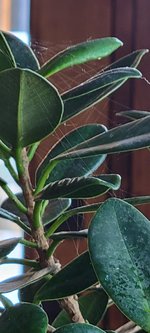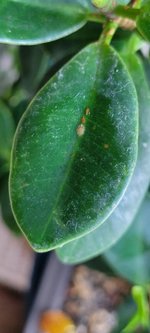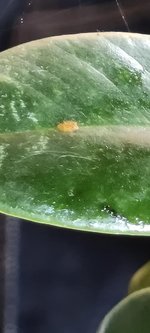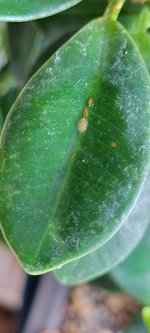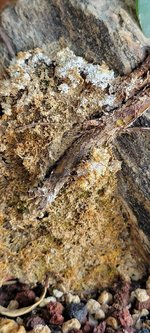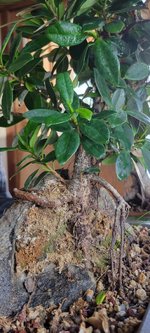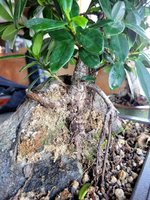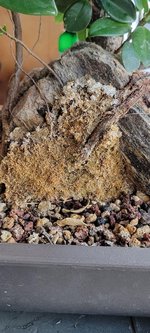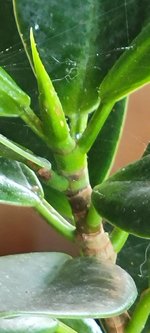UnmovedMover
Seedling
Hey All -
I have a ficus that I've been taking care of since March of this year. The only work I've done on it was some light trimming and a good bit of wiring. Beyond that, I gave it sunlight, water, and fertilizer. It seemed healthy and happy to my rookie eyes all summer and into fall. I live in a 4a zone so this ficus was getting outside time during the summer months and in the fall moved inside to a south facing window. For a few months I noticed that the need to water lessened but everything else looked fine. There wasn't any exploding new growth to speak of, but nothing looked ill or unhappy.
Recently, I noticed a few leaves had fallen from the ficus. I thought that perhaps I had neglected it through the business of the holidays and is needed water. I gave it a pretty solid drink as I wasn't too concerned about over-watering seeing that I knew it had been at least 5-6 days since I had last watered it and I the soil components (see pictures below) are fast draining, not likely that some extra water would result in soggy roots. While watering the tree however, I saw more problems. Slight movement was enough to cause an alarming amount of leaves to fall. I collected the fallen leaves and laid them out as to inspect them and take some pictures, which I have included in this thread / post. Some of the leaves seemed dry, but none were so bad that they turned to dust when I handled them. The color of the leaves is what I first noticed as a major red flag that something was wrong. The tree normally has uniform, rich, deep green leaves. Now however, there is a mix of brow, yellow, and pale green mixed with the healthier, darker, coloring. Most of the leaves that fell looked unhealthy, but there were some that didn't look bad. One commonality with the leaves that fell off as I was watering was that they were all curling in on themselves (lengthwise so the two longer sides were curling up towards each other). In many cases I had to unfold them and apply a bit of pressure to get them to lay flat so I could take the photos.
As you can see in the pictures, there are several instances of what I believe to be evidence of pests. I had already watered the tree, including from the top through the leaves and branches. I don't know if I knocked away more of this evidence before I noticed it and stopped. I did my best to try and get these in a focused zoomed in picture but it wasn't easily done.
I quickly searched online and a few reference books but without seeing evidence of any active bugs I'm not confident in diagnosing what my unwelcome guests might be. Perhaps I did away with some through the extended watering, but I get the feeling this ficus is in trouble based on the amount of leavces it has lost (in the past few hours it's dropped a few more and anytime I so much as look at it, another leaf drops). The black spots in some of the pictures could be fungus, chlorosis could be causing some of the yellowing in the leaves? There are some white 'things' on some leaves, in one picture this can be seen and it's surrounded by sickly pale green, with the rest of the leaf looking more normal. Many leaves have a dried white powder type look to them, almost like hard water stains or mildew. My water is naturally hard but everything this plant has been given has gone through a treatment system. There are a few other growth/callous looking shapes on the branches. Many pest descriptions mention things like this, so I'm hoping the pictures might be good enough for someone here to have seen some of these things before. It could simply bne that he short daylight hours are taking a tole and I need to get this ficus under some grow lights. This tree was supposed to be in a greenhouse but through a series of unfortunate events, it is not, and I'm trying to make it work through this winter in my house. I have no problem getting it additional light and I could try and set up a small space with more humidity and heat (it's cold and dry by nature here). I don't want to change too many things on an already stressed tree but if the cold, dry, low light days made the ficus an easy target for pests to come in and cause more damage, it might make sense to make some environment changes for the tree ASAP.
I am planning on spraying the leaves and branches (top and bottom) with the pesticide I have on hand called 'Uncle Bill's All Naturla Pesticide' (pictures of it included with this post). I also have some Neem products and potentially a few others in the general garden supplies. I'm looking to see what people here think. Is the pesticide a good idea? Is there anything else I should try first? Is this a decent product to use in this scenario (if not, what might a better replacement be)? Is the environmental change a good idea to try now? Try in a week after seeing how the pesticide does? Anything else I can do to keep this tree alive? To me, this seems relatively dire, but I'd be interested to see how serious others think this is. Is this is a 50/50 chance the tree dies, or 90/10, 10/90?
I have some more pictures, and can take more as needed. I'm limited to 16 on this post and phone camera quality when ultra zoomed in is not amazing. Hopefully good enough to get some diagnostics done, but let me know if you want a specific shot or area taken again - I'm happy to do that!
Thanks in advance for any suggestions you might have!
Pictures:



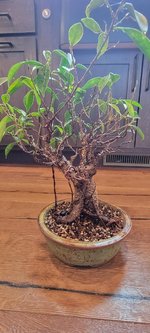
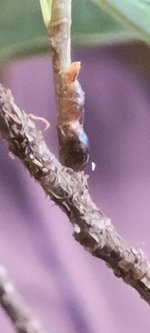
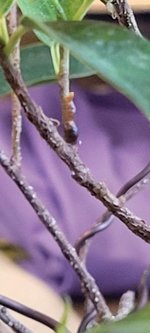

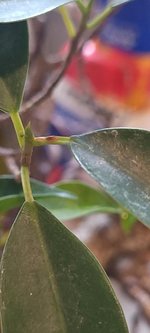

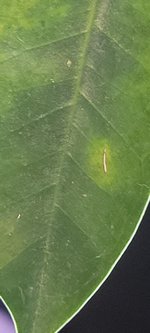
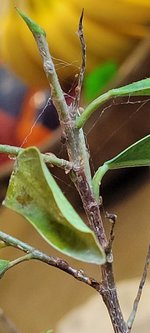
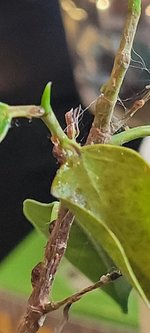

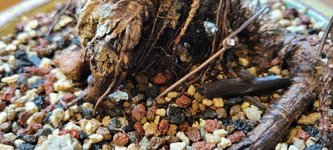
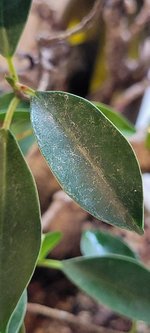

I have a ficus that I've been taking care of since March of this year. The only work I've done on it was some light trimming and a good bit of wiring. Beyond that, I gave it sunlight, water, and fertilizer. It seemed healthy and happy to my rookie eyes all summer and into fall. I live in a 4a zone so this ficus was getting outside time during the summer months and in the fall moved inside to a south facing window. For a few months I noticed that the need to water lessened but everything else looked fine. There wasn't any exploding new growth to speak of, but nothing looked ill or unhappy.
Recently, I noticed a few leaves had fallen from the ficus. I thought that perhaps I had neglected it through the business of the holidays and is needed water. I gave it a pretty solid drink as I wasn't too concerned about over-watering seeing that I knew it had been at least 5-6 days since I had last watered it and I the soil components (see pictures below) are fast draining, not likely that some extra water would result in soggy roots. While watering the tree however, I saw more problems. Slight movement was enough to cause an alarming amount of leaves to fall. I collected the fallen leaves and laid them out as to inspect them and take some pictures, which I have included in this thread / post. Some of the leaves seemed dry, but none were so bad that they turned to dust when I handled them. The color of the leaves is what I first noticed as a major red flag that something was wrong. The tree normally has uniform, rich, deep green leaves. Now however, there is a mix of brow, yellow, and pale green mixed with the healthier, darker, coloring. Most of the leaves that fell looked unhealthy, but there were some that didn't look bad. One commonality with the leaves that fell off as I was watering was that they were all curling in on themselves (lengthwise so the two longer sides were curling up towards each other). In many cases I had to unfold them and apply a bit of pressure to get them to lay flat so I could take the photos.
As you can see in the pictures, there are several instances of what I believe to be evidence of pests. I had already watered the tree, including from the top through the leaves and branches. I don't know if I knocked away more of this evidence before I noticed it and stopped. I did my best to try and get these in a focused zoomed in picture but it wasn't easily done.
I quickly searched online and a few reference books but without seeing evidence of any active bugs I'm not confident in diagnosing what my unwelcome guests might be. Perhaps I did away with some through the extended watering, but I get the feeling this ficus is in trouble based on the amount of leavces it has lost (in the past few hours it's dropped a few more and anytime I so much as look at it, another leaf drops). The black spots in some of the pictures could be fungus, chlorosis could be causing some of the yellowing in the leaves? There are some white 'things' on some leaves, in one picture this can be seen and it's surrounded by sickly pale green, with the rest of the leaf looking more normal. Many leaves have a dried white powder type look to them, almost like hard water stains or mildew. My water is naturally hard but everything this plant has been given has gone through a treatment system. There are a few other growth/callous looking shapes on the branches. Many pest descriptions mention things like this, so I'm hoping the pictures might be good enough for someone here to have seen some of these things before. It could simply bne that he short daylight hours are taking a tole and I need to get this ficus under some grow lights. This tree was supposed to be in a greenhouse but through a series of unfortunate events, it is not, and I'm trying to make it work through this winter in my house. I have no problem getting it additional light and I could try and set up a small space with more humidity and heat (it's cold and dry by nature here). I don't want to change too many things on an already stressed tree but if the cold, dry, low light days made the ficus an easy target for pests to come in and cause more damage, it might make sense to make some environment changes for the tree ASAP.
I am planning on spraying the leaves and branches (top and bottom) with the pesticide I have on hand called 'Uncle Bill's All Naturla Pesticide' (pictures of it included with this post). I also have some Neem products and potentially a few others in the general garden supplies. I'm looking to see what people here think. Is the pesticide a good idea? Is there anything else I should try first? Is this a decent product to use in this scenario (if not, what might a better replacement be)? Is the environmental change a good idea to try now? Try in a week after seeing how the pesticide does? Anything else I can do to keep this tree alive? To me, this seems relatively dire, but I'd be interested to see how serious others think this is. Is this is a 50/50 chance the tree dies, or 90/10, 10/90?
I have some more pictures, and can take more as needed. I'm limited to 16 on this post and phone camera quality when ultra zoomed in is not amazing. Hopefully good enough to get some diagnostics done, but let me know if you want a specific shot or area taken again - I'm happy to do that!
Thanks in advance for any suggestions you might have!
Pictures:


















